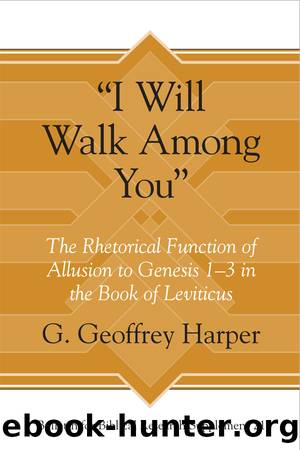I Will Walk Among You by Harper G. Geoffrey;Eisenbrauns (Firm);

Author:Harper, G. Geoffrey;Eisenbrauns (Firm);
Language: eng
Format: epub, pdf
Publisher: Pennsylvania State University Press
The Recontextualization of Prior Material
A third criterion for testing whether intertextual parallels are intentionally deployed is determining whether prior material has been recontextualized. Albeit counterintuitive, the reworking of a text for a new situation is a better indicator of dependence than verbatim quotation (see chapter 2). Lyons notes that such âcreative interactionâ can take numerous forms: âAn author can interpret an earlier text, use it as a basis for an argument, disagree with it, or reuse its words to create a new argument.â113 Important, therefore, are several ways in which Lev 11 has refashioned material that appears in Gen 1â3.
First, Lev 11 uses the description of YHWHâs actions at creation to prescribe Israelâs actions in the present. Just as YHWH established order through separation (××× hiphil) on a cosmic scale, so Israelâs priests (Lev 10:10), and people generally (Lev 11:47; cf. 11:2), are to establish order through separation (××× hiphil) on a microcosmic scale. Part of that ordering activity is the proper categorizing of creatures âaccording to their kindâ (××× + ×). Therefore, just as God populated the three spheres of sky, water, and land with their respective avian, aquatic, terrestrial, and âswarmingâ denizens (Gen 1:20â21, 24â26), so Israel is to think in similar terms and categorize accordingly. In this way, Israel is instructed to act as YHWH himself acted, to actively engage in imitatio Dei in relation to the ordering of the world (cf. Lev 11:44â45).
Second, multiple elements of the Garden of Eden story are reworked in a legislative setting. The primordial grant of food (Gen 1:29; 2:16) with subsequent limitation (Gen 2:17) is echoed in Lev 11 using the same language. This time, however, the recipient of the divine allocation of food is not Adam, but Israel en masse (Lev 11:2). So also, it is now Israel that receives limitations on what may be eaten (Lev 11:4 et passim). Moreover, as noted earlier, the wider contours of the Gen 2â3 narrative vis-Ã -vis the motif of eating are represented in Lev 11. Along similar lines, there is also recontextualization of Eveâs âtouching.â In Gen 3, a prohibition against touching is the womanâs innovation. In Lev 11:8, which like Gen 3:3 employs the rare pairing of ××× and × ××¢, touching is disallowed by YHWHâs command. Thus, the verbal allusion is present, but it is doing different work.
Third, the making of allusion often involves reworking the original syntax; that is, the actual forms used are contextually and grammatically determined by the alluding text. This is exactly what is found in Lev 11; for example, with regard to the unique syntactical cluster of ××× + ×¢× + ××××. The direct address of the serpent in Gen 3:14 is reflected in the second-person forms of both verb and pronominal suffix (×¢×Ö¾××× × ×ª××). Leviticus 11:42, in contrast, reworks the same verb, preposition, and noun combination in order to delineate a category of creature (×× ×××× ×¢×Ö¾××××), one that by virtue of the rare combination recalls the Edenic serpentâs cursed mode of locomotion. This shared
Download
I Will Walk Among You by Harper G. Geoffrey;Eisenbrauns (Firm);.pdf
This site does not store any files on its server. We only index and link to content provided by other sites. Please contact the content providers to delete copyright contents if any and email us, we'll remove relevant links or contents immediately.
The Power of Myth by Joseph Campbell & Bill Moyers(925)
Half Moon Bay by Jonathan Kellerman & Jesse Kellerman(911)
A Social History of the Media by Peter Burke & Peter Burke(879)
Inseparable by Emma Donoghue(844)
The Nets of Modernism: Henry James, Virginia Woolf, James Joyce, and Sigmund Freud by Maud Ellmann(738)
The Spike by Mark Humphries;(719)
A Theory of Narrative Drawing by Simon Grennan(705)
The Complete Correspondence 1928-1940 by Theodor W. Adorno & Walter Benjamin(703)
Ideology by Eagleton Terry;(657)
Bodies from the Library 3 by Tony Medawar(648)
Culture by Terry Eagleton(646)
World Philology by(645)
Farnsworth's Classical English Rhetoric by Ward Farnsworth(641)
A Reader’s Companion to J. D. Salinger’s The Catcher in the Rye by Peter Beidler(614)
Adam Smith by Jonathan Conlin(606)
Game of Thrones and Philosophy by William Irwin(592)
High Albania by M. Edith Durham(589)
Comic Genius: Portraits of Funny People by(581)
Monkey King by Wu Cheng'en(575)
